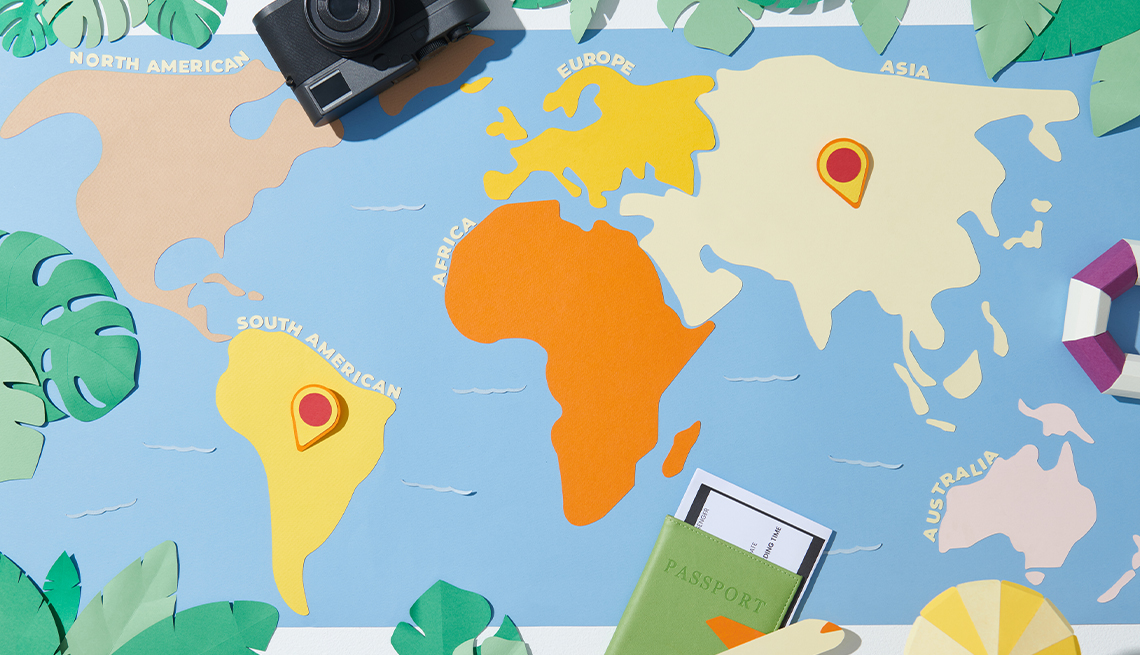
- Select a language for the TTS:
- UK English Female
- UK English Male
- US English Female
- US English Male
- Australian Female
- Australian Male
- Language selected: (auto detect) - EN
Play all audios:
Getty Images SMART TRAVEL 35. MIND YOUR MANNERS (AND VOICE LEVEL) Travel is a time to let loose and have fun, but while you’re doing so, remember to be polite and monitor your voice volume,
Al-Hazzá says. “Don’t be loud when having conversations,” she says. “It screams tourist.” This is particularly important in enclosed places, such as museums or restaurants, so be sure to
read the room and be mindful of others around you. 36. KNOW YOUR SURROUNDINGS It’s easy to get lost in the moment — that’s what travel is all about — but don’t get _too_ distracted, Al-Hazzá
says. “Always look people in the eye and know who’s around you,” she says. “This should be a given, but also don’t go to deserted areas at night.” Additionally, be smart about your
belongings. You don’t have to use a money belt, but use bags and purses that have locking zippers and or compartments or can be worn cross-body style — anything to deter a potential
pickpocket. Large cities such as Barcelona, Paris, Madrid and Rome boast busy city centers with many distractions — and a lot of opportunities to be separated from your phone and wallet. 37.
GET CASH FROM A TRUSTWORTHY ATM Don’t get your cash supply from that sketchy side-of-the-road ATM. Instead, Richard says, head to the local bank. “Use an official bank ATM, preferably one
inside the bank with cameras for safety,” she says. Additionally, look for debit cards that offer international fee-free withdrawals before your trip. 38. PURCHASE IN THE LOCAL CURRENCY
Before you go to pay for a meal or souvenir, heed Richard’s payment advice: “When a store lets you choose between being charged in local currency or U.S. dollars, go for the local currency.
Your credit card will adjust the cost for you automatically based on the official exchange rate of the day.” 39. DOWNLOAD OFFLINE MAPS If you’re the navigator of your travel group, or you’re
heading out solo, make sure to download offline maps of your destination before you leave home, Rylander says. On Google Maps, you can download a full city map or even a country map to use
without cell service. To do this, open the app and search for the location, then below the location (and to the right of “Directions”), scroll to the right and select “Download Offline Map.”
Once the map is downloaded, click on your profile photo near the search bar and scroll down to “offline maps.” Other apps with downloadable maps include HERE WeGo Maps & Navigation and
Sygic GPS Navigation & Maps. 40. CONNECT ON THE GO When the need for internet arises, Rylander has tips for snagging Wi-Fi on the go. “Wi-Fi is prevalent in cafes, hotel lobbies and
sometimes even in grocery stores,” she says, but connecting to public Wi-Fi gives savvy hackers easy access to your personal information, so use a VPN or a virtual private network service to
protect yourself. A VPN costs $30 to $100 per year. Alternatively, use your smartphone’s hot spot to connect to the internet more securely. 41. TAKE FOOD REVIEWS WITH A GRAIN OF SALT Review
sites can help you avoid problematic hotels or meals, but Rylander suggests keeping an open mind. “Don’t get too hung up on reviews,” she says. “They’re great for a general reference, but
people have different tastes. Don’t be afraid to try a place even if the reviews are, say, a 4.1 instead of five stars.” 42. ASK BEFORE YOU PHOTOGRAPH With smartphones, snapping photos has
become second nature, but it’s important to remember photography etiquette when you’re traveling. “Ask people before you take a photo of them, and don’t just walk into a restaurant and stick
your camera in a person’s face,” Rylander says, noting the same goes for street performers, animals and especially children. 43. USE YOUR PHONE CARRIER ABROAD These days, you don’t
necessarily need a new international phone or special SIM card to use your smartphone internationally. According to Kirkpatrick, most phone carriers offer international day passes for $5 to
$10 per day. “It’s easy to just add this plan onto your current cellular phone plan and not worry about the SIM card,” she says. Getty Images HAVE FUN 44. HIT THE LOCAL MARKET See the city
like a local with a trip to your destination’s neighborhood markets. “You can meet locals at markets, or by taking classes, like cooking or pottery, hosted by locals,” Al-Hazzá says. You can
research the markets ahead of time, or ask your concierge, restaurant hostess or shopkeepers for tips throughout your trip. 45. TRY A FOOD TOUR Food is the heartbeat of a city. To soak up
the local flavors, and the cultural history, book a food tour, Rylander says. “I love a food tour, usually on day one or day two of the trip, because it helps you get oriented around the
city, and you get an introduction to the local food,” she says. Even better: If you really love the dish, you’ll have time to try it again. 46. ASK FOR LOCAL RECOMMENDATIONS You may be
tempted to plan your entire trip before even touching down, but Dawit Habtemariam, global tourism reporter at Skift, suggests leaving room for local recommendations from people who don’t
necessarily work in the tourism industry. Another place he finds out-of-the-box recommendations is through TikTok. “It’s a search engine for a lot of people now,” Habtemariam says. 47. LOOK
FOR EVENTS IN THE LOCAL NEWSPAPER Habtemariam may be a fan of TikTok for travel, but he also recommends sticking to the classics: newspapers. “When I was in Reykjavik, I found a local
newspaper with music listings, and I kept going to these cool live music shows,” he says, noting he also found restaurant and bar ideas via print papers. “This old-fashioned way has some
hidden gems.” 48. FIND NICHE-INTEREST EVENTS To meet local people in an authentic way, join a niche event. “I’m a big improv person, so I look up social gatherings around this hobby,”
Habtemariam says. “In Berlin, I went to an improv comedy café and got to perform with the locals.” You can find these kinds of events for all sorts of interests: photography, painting,
pottery, cooking, history, running — you name it. 49. BE A SAVVY SOUVENIR SHOPPER It may be tempting to scoop up every souvenir in sight, but Al-Hazzá cautions against overdoing it. “Think
about if this is something you’ll want in five years,” she says. “The local attire is probably beautiful, but will you actually wear it back home?” If you’re deciding between items, aim to
purchase something that’s unique to the country. 50. LEAVE ROOM FOR SPONTANEITY It’s helpful to start your trip with an agenda, but leave room for spontaneity. “Be willing to abandon the
agenda if something else comes along,” Al-Hazzá says. “Those are usually the most memorable experiences. If you have the opportunity to do something with the locals, do it, because then you
gain an authentic experience.” 51. BE IN THE MOMENT From new architecture to interesting food, it can be easy to take hundreds of photos without even realizing it. There’s nothing inherently
wrong with this, but Rylander suggests being intentional about how you photograph so you don’t miss the moment. “Don’t feel like you need to capture every second,” she says. “Think about
whether this is something you personally will want to look back on.” 52. WHEN TO SNAG A RESTAURANT RESERVATION In some places, restaurant reservations are a must. In other cities, they’re a
rarity. Rylander suggests researching your destination’s stance on them; if they’re common in your getaway, snag them early — especially come summer. “If you really have your hopes set on a
place, make a reservation,” she says. Getty Images DESTINATION ALTERNATIVES The bounce-back of international travel has left some destinations struggling from overtourism. To help you avoid
the crowds, we asked travel professionals for their recommendations on alternatives to the most popular (read: busiest) destinations. Their destination swaps include: 53. INSTEAD OF
MALLORCA, SPAIN, TRY MENORCA, SPAIN Mallorca’s powder-soft beaches and teal waters may be alluring, but for another captivating and less busy escape, try Menorca, Spain, Al-Hazzá says. This
low-key destination is like a postcard from paradise, with clear turquoise waters, secluded shorelines and an abundance of marine life. 54. INSTEAD OF ROME, TRY PUGLIA Sure, Rome is iconic,
but the crowds can feel overbearing. As an alternative, Al-Hazzá recommends Puglia in southern Italy. You’ll find ancient villages, fresh-grown fare and access to the Adriatic, sans big-city
crowds. 55. INSTEAD OF SANTORINI, TRY MILOS There’s a reason Santorini tops bucket lists. The Cyclades island dazzles with whitewashed villages perched atop crystal waters, but heavy
throngs of tourists can dim the magic. Instead, Al-Hazzá suggests Milos, another Greek island with paper-white abodes overlooking the shimmery sea, a laid-back beachcombing culture,
otherworldly cliffs and caves and most important: a fraction of the Santorini crowds. 56. INSTEAD OF TANZANIA’S SERENGETI, TRY SOUTH AFRICA’S SABI SAND NATURE RESERVE “Rather than the
Serengeti, we recommend South Africa’s Sabi Sand Nature Reserve to our clients because of the easy airlift from the U.S., and it offers a great value of the rand currency against the USD
right now,” says Sunit Sanghrajka, founder and CEO of Alluring Africa, a boutique travel-planning team focused on Africa. This alternative is not only a quick flight from Johannesburg; it
also has a lower malaria risk, and the chance to see all of Africa’s famed animals, such as lions, elephants and leopards. “You can get close to the game without the overcrowding seen lately
in Kenya,” Sanghrajka says. 57. INSTEAD OF MUNICH, TRY NUREMBERG Charming Munich attracts tourists with its diverse architecture, bucket-list sights and famous frivolity, but Rylander
recommends a less-crowded — yet equally charming — German escape: Nuremberg, a haven for art, architecture and history. 58. INSTEAD OF PRAGUE, TRY OSTRAVA Cobblestone-adorned Prague may be a
fairy-tale destination, but it’s also one of Europe’s most visited cities. For an alternative, Rylander recommends less-trodden Ostrava in the Czech Republic. The getaway, near the border
with Poland, delights with a colorful main square, a three-nave Neo-Renaissance basilica and buzzing pubs and restaurants.








